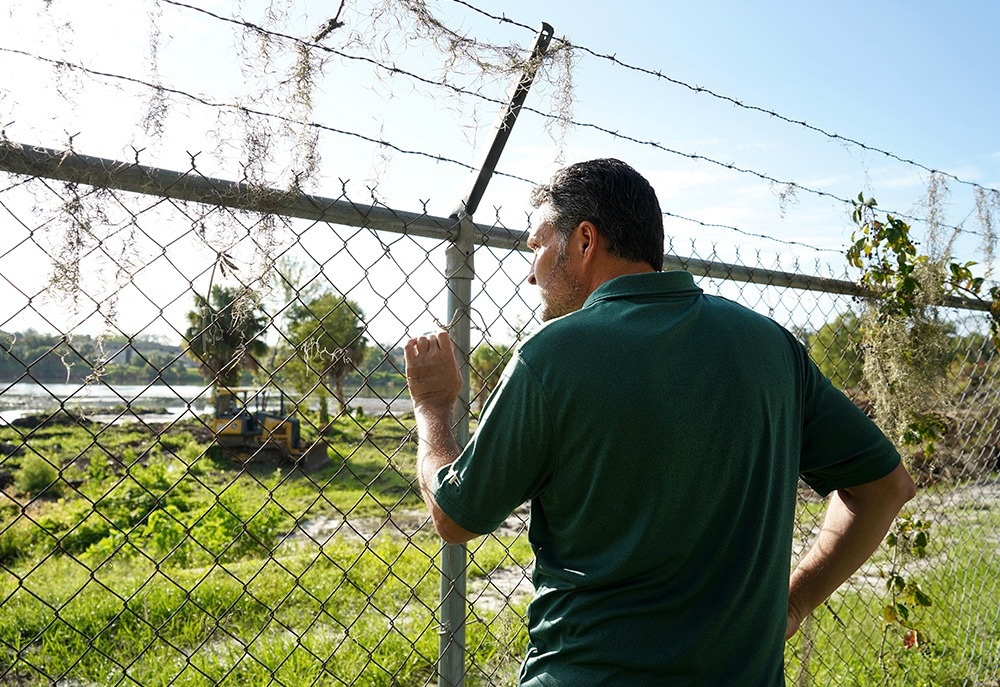An interdisciplinary team of University of South Florida researchers is aiming to safeguard the environment by preventing pollutants from entering a local stormwater pond, which runs into Tampa Bay and the Gulf of Mexico.
 Professor Christian Wells visiting Aaran’s Pond. Image Credit: Cassidy Delamarter
Professor Christian Wells visiting Aaran’s Pond. Image Credit: Cassidy Delamarter
Aaran’s Pond in Tampa’s University Area Community, where more than one in three residents remain below the federal poverty level, is getting a bio-infiltration system installed, thanks to a three-year, $1.5 million grant from the US Environmental Protection Agency. The team behind this project includes the University of Florida.
Aaran’s Pond
When it rains, contaminants, including fertilizer, oil, animal waste, and decaying vegetation, are washed down gutters and fed into an existing stormwater pond, stated the study’s principal investigator, Professor Sarina Ergas of the USF Department of Civil and Environmental Engineering.
Due to this, addressing urban runoff in underprivileged regions is difficult, especially given that stormwater ponds are frequently overflowing with waste and are impossible to maintain due to restrictive fences and steep slopes.
We are calling them inert zombies due to their lack of life. If you look at the difference between a stormwater pond in a wealthy neighborhood and one in a low-income neighborhood—it is day and night in terms of how they benefit the community.
Sarina Ergas, Study Principal Investigator, Department of Civil and Environmental Engineering, University of South Florida
These contaminants eventually flow into the Hillsborough River and Tampa Bay, which feed into the Gulf of Mexico, if not taken out of the ponds. Nitrogen is one of the nutrients that cause toxic algal blooms, kills sea grass, and lowers the amount of oxygen in the water.
To enhance nutrient removal, the team is working with Oldcastle Infrastructure to build four additional bio-infiltration systems around the pond. Biochar, a substance like charcoal that helps minimize nutrient pollution and promotes microbial activity and plant development, will be used in the systems to hold and treat the runoff water.
This is the first-time biochar has been utilized in a pond to enhance water quality; previous research with biochar has taken place in the lab.
The Hillsborough County Engineering and Operations Department and the USF team are redesigning the pond along with Mary Lusk, a University of Florida expert in stormwater ponds and their functions. To offer extra filtration and improve the pond’s aesthetics, it is planned to plant bio-infiltration systems with plants and shrubs along the steep slopes.
We strongly believe the efforts undertaken by this project, along with our collaboration in its implementation, will result in positive, long-term benefits for our community. As partners, we share in the goal of leveraging resources to improve human and environmental health and the social well-being of residents who live in the community.
Sarah Combs, Chief Executive Officer, University Area Community Development Corp
The initiative, according to Professor Christian Wells of the Department of Anthropology, is “an opportunity to reimagine what stormwater ponds can do for communities.”
Wells will conduct a survey of nearby people with the assistance of graduate students to identify initiatives that address the community’s needs. The information will be utilized to increase recreational possibilities and inhabitants' access to green space by adding additional amenities such as picnic tables, walking pathways, and a park.
Serena Echols, a graduate student, is looking forward to the community outreach.
This aligns with my passion for placekeeping native populations of people and plants so their stories are not forgotten nor unconsidered when redevelopment occurs.
Serena Echols, Graduate Student, University of South Florida
Wells added, “Looking toward the future, five years from now, I don’t see a polluted stormwater pond. Instead, I see a beautiful lake surrounded by trees and a bustling park filled with children and their families learning about the importance of university-community partnerships that create positive change.”
In the process, USF students and staff, according to Wells, are creating capacity for environmental justice and equitable development, which could result in healthy, sustainable, and economically productive communities. After the three-year project is completed, the team expects that this project will serve as a model for stormwater ponds in the future.
Sarina Ergas, Mauricio Arias, Mahmood Nachabe, Qiong Zhang, James Mihelcic, and Christian Wells from USF, Mary Lusk from the University of Florida, the University Area Community Development Corp., the Hillsborough County Engineering and Operations Department, Oldcastle Infrastructure, and Sunshine Organics and Compost are leading this project.